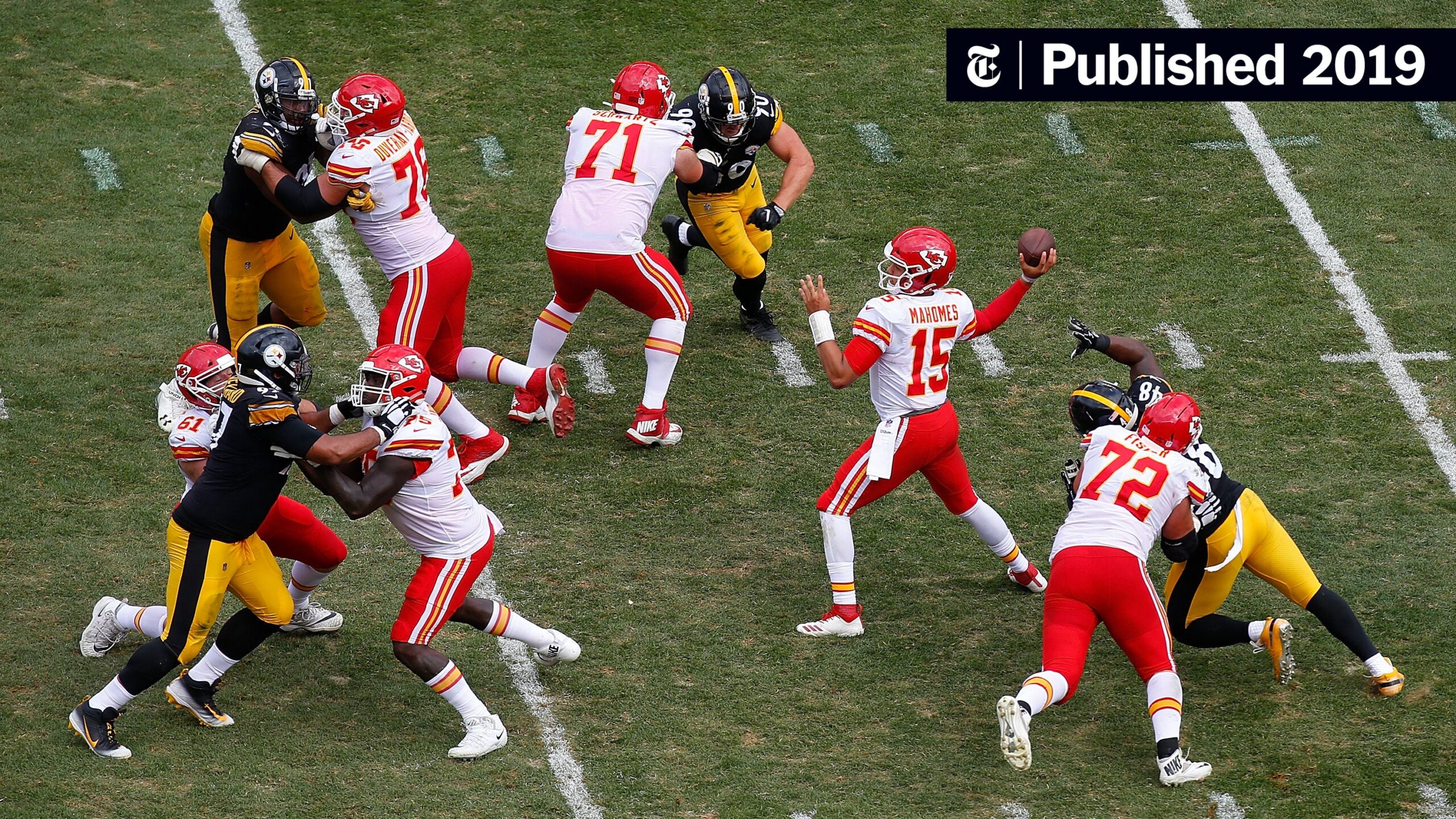American football offensive line strategies focus on coordination, communication, and blocking techniques to create opportunities for the running backs and protect the quarterback. These strategies involve blocking specific defenders, executing complex schemes, and adjusting tactics based on the defensive alignment.
A well-coordinated offensive line can open up running lanes and provide a clean pocket for the quarterback, leading to successful offensive plays. Additionally, offensive linemen must have a strong understanding of plays, formations, and their individual responsibilities to execute these strategies effectively.
The success of an offensive line hinges on their ability to work as a cohesive unit and make split-second decisions to counter the defense’s movements.
The Importance Of Offensive Line Strategies
The Importance of Offensive Line Strategies
The success of a team in American football heavily relies on the effectiveness of offensive line strategies. A well-coordinated offensive line is crucial in creating opportunities for the team’s offensive plays. The strategies implemented by the offensive line directly impact the overall performance and success of the team.
Effective offensive line strategies serve to maximize the team’s performance by enabling key elements such as:
- Protection: One of the primary roles of the offensive line is to protect the quarterback. Implementing sound strategies ensures that the quarterback has enough time to make plays while minimizing the risk of being sacked. This enables the team to maintain possession of the ball and progress towards scoring.
- Run Blocking: Offensive line strategies also play a crucial role in creating running lanes for the team’s running backs. By effectively blocking the defensive players, the offensive line opens up opportunities for successful running plays. This helps in controlling the game’s tempo and keeping the defense guessing.
- Field Awareness: Strategic offensive line play involves understanding the opposing team’s defense, identifying potential weaknesses, and exploiting them. This requires coordination, communication, and quick decision-making to adjust the blocking schemes accordingly.
The impact of offensive line strategies transcends individual positions and affects the entire team’s success. A cohesive offensive line ensures that the offensive unit as a whole can execute plays efficiently, increasing the team’s chances of winning. Therefore, investing in a strong offensive line and implementing effective strategies is vital for sustained success in American football.
Understanding The Basics
Offensive line play in American football is crucial for a team’s success. It requires a solid understanding of positioning and roles. The offensive line consists of five positions: center, guards, and tackles. Here’s a breakdown of their responsibilities:
| Position | Responsibility |
|---|---|
| Center | Snap the ball to the quarterback, pass block, and lead blocking for run plays. |
| Guards | Protect the quarterback, create running lanes, and provide support to tackles. |
| Tackles | Block defensive players, protect the quarterback’s blind spot, and create outside running lanes. |
Each position requires specific techniques, such as footwork, hand placement, and maintaining leverage. Effective communication among the offensive linemen is crucial for executing strategies and adjusting to defensive formations. They work together to create time and space for the quarterback, allowing for successful plays.
In conclusion, understanding offensive line positions and their roles is essential for American football teams. It allows for efficient execution of strategies and maximizes the team’s chances of scoring. By working as a cohesive unit, the offensive line significantly contributes to a team’s offensive success.
Key Elements Of Effective Offensive Line Strategies
Effective offensive line strategies in American football involve key elements such as communication, coordination, technique, and execution.
Communication and coordination are crucial for the offensive line to work as a unit. Players need to effectively communicate with each other to understand their blocking assignments and potential adjustments based on the defensive alignment. Coordinating their movements and actions ensures synchronized movements and maximizes the effectiveness of blocking schemes.
Technique plays a vital role in offensive line strategies. Players must excel in various blocking techniques such as drive blocking, reach blocking, and zone blocking to create running lanes or provide protection for the quarterback. Proper footwork, hand placement, and leverage are essential for successfully executing these techniques.
Execution is the ultimate goal of offensive line strategies. Players must execute their assignments with precision and discipline. This includes maintaining proper timing, hitting the right targets, and sustaining blocks to enable the offense to gain yardage and control the line of scrimmage.
Mastering The Fundamentals
The offensive line plays a crucial role in American football, and it’s essential for players to master the fundamentals. Two key aspects to focus on are stance and hand placement, as well as footwork and body positioning.
Stance and Hand Placement
The stance is the foundation for a successful offensive lineman. They must have a balanced and powerful posture, with their feet shoulder-width apart and knees slightly bent. Hand placement is equally important, as it allows for optimal control and leverage against opposing defenders. The hands should be positioned on the inside of the defender’s chest, maintaining a strong grip without holding or grabbing.
Footwork and Body Positioning
Efficient footwork enables offensive linemen to maintain proper positioning and quickly respond to defensive movements. They should focus on short and quick steps to stay agile and maintain balance. Body positioning involves maintaining a low center of gravity to generate power and leverage during blocks. A low, wide base allows for stability and helps in absorbing opponents’ charges.
Building Strength And Power
Weight training and conditioning are essential components of a successful offensive line strategy in American football. The offensive line players must have the strength and power to withstand the physical demands of the game and effectively execute their blocking assignments. Functional exercises play a crucial role in developing the required strength and power.
Functional exercises are exercises that mimic the movements and muscle groups used in football. These exercises include squats, deadlifts, bench presses, and power cleans. By incorporating these compound movements into their training routine, offensive linemen can build overall strength and power in their lower body, core, and upper body.
| Functional Exercises for Building Strength and Power |
|---|
| Squats |
| Deadlifts |
| Bench Presses |
| Power Cleans |
By consistently incorporating weight training and conditioning exercises into their training regimen, offensive linemen can enhance their strength and power, enabling them to effectively dominate their opponents on the field. It is important to remember that proper form, progression, and recovery are crucial when implementing these exercises to minimize the risk of injuries and maximize performance.
Creating Effective Blocking Techniques
| American Football Offensive Line Strategies | |
|---|---|
| Creating Effective Blocking Techniques | |
| Zone blocking | Man-to-man blocking |
| The zone blocking technique focuses on creating lanes for the running back by having offensive linemen work together to block an area rather than a specific defender. It requires quick coordination, precise footwork, and the ability to read the defense to determine the best blocking angles. | In man-to-man blocking, each lineman is assigned a specific defender to block. This technique relies on individual strength, technique, and positioning to create holes for the running back. It requires effective hand placement, leverage, and understanding of defensive schemes to successfully neutralize the assigned defender. |
Developing Effective Pass Protection Strategies
Identifying and Countering Defensive Schemes
In order to build an effective pass protection strategy in American football, it is crucial to first identify and analyze the defensive schemes employed by the opposing team. By conducting thorough research and film study, offensive coaches and players can gain valuable insights into the defensive strategies used by their opponents.
When facing blitzes, it becomes important for the offensive line to recognize and react quickly. Communication and coordination are key to effectively picking up blitzes, as the offensive linemen need to work together to provide proper protection to the quarterback. Additionally, understanding how to counter stunts is crucial. Stunts involve defensive linemen exchanging their rush lanes to create confusion and disrupt the offensive line.
To counter these defensive tactics, the offensive line must maintain proper technique and footwork. Strong fundamentals, such as quick lateral movement and maintaining balance, are essential in successfully thwarting defensive schemes. Offensive linemen should remain alert and adaptable, ready to adjust their blocking assignments based on the movements of the opposing defenders.
Strategic Adjustments For Different Game Situations
American Football Offensive Line Strategies involve strategic adjustments for different game situations.
Adjustments for Run Plays:
- Identify the defensive alignment to understand potential gaps for the running back.
- Communicate effectively with the other offensive linemen to block the defenders and create running lanes.
- Execute double-team blocks to overpower the opposing defenders.
- Adjust blocking angles based on the movement of the defensive front.
- Maintain proper hand placement and leverage to gain control over the defenders.
- Make quick adjustments during the play if the defense shifts or blitzes.
Adjustments for Passing Plays:
- Prioritize pass protection by using proper footwork and techniques to reinforce the offensive line.
- Recognize and adjust to different types of pass rushes.
- Coordinate with the running back to pick up any potential blitzes.
- Create a solid pocket for the quarterback, using proper spacing and depth.
- Adjust blocking assignments based on the defensive formations.
- Stay aware of stunts and twists by the defense, making necessary adjustments.
Utilizing Film Study For Performance Enhancement
American Football Offensive Line Strategies
One of the most effective strategies for enhancing performance in American football is utilizing film study. This involves analyzing opponent tendencies and identifying their weaknesses and strengths. By carefully studying game footage, offensive line players can gain valuable insights into their opponents’ defensive formations, blitz packages, and individual player tendencies. This allows them to develop effective blocking schemes and better anticipate the movements of the defensive line. Additionally, film study enables offensive linemen to recognize patterns, exploit vulnerabilities, and make accurate pre-snap adjustments. By thoroughly studying the opponent’s defensive line, linebackers, and defensive backs, offensive linemen can enhance their performance and effectiveness on the field. Film study provides a competitive advantage by equipping offensive linemen with the necessary knowledge to make informed decisions and execute successful plays.
Incorporating Game Plans And Playbooks
Understanding the offensive scheme is crucial to the success of a football team. It involves analyzing the strengths and weaknesses of the opposing defense and devising a game plan to exploit their vulnerabilities. Coaches spend hours working on the playbook, which contains a wide variety of designed plays that cater to the team’s strengths. Executing these plays efficiently requires the offensive line to work in sync. Each player has a specific role, whether it’s blocking for the quarterback or creating running lanes for the running back. Communication and coordination are key, as the offensive line needs to quickly react to the defense’s movements and adjust their blocking accordingly. By incorporating game plans and playbooks, teams can strategically outmaneuver their opponents and achieve offensive success.

Credit: www.amazon.com
Frequently Asked Questions On American Football Offensive Line Strategies
What Are The Offensive Strategies In Football?
Offensive strategies in football involve tactics such as running plays, passing plays, and varying formations.
How Do I Become A Better Offensive Lineman?
To become a better offensive lineman, follow these steps: 1. Focus on improving your strength, agility, and technique. 2. Practice proper footwork, hand placement, and blocking techniques regularly. 3. Study and understand offensive line schemes and strategies. 4. Seek feedback from coaches and teammates to fine-tune your skills.
What Is The Hardest Position To Play On The Offensive Line?
The most challenging position on the offensive line is the center due to their crucial role in directing plays and coordinating with teammates.
How Do You Block A Lineman Bigger Than You?
To block a lineman bigger than you, use proper technique, leverage, and quick footwork.
Faq 1: What Are The Key Duties Of An Offensive Lineman In American Football?
The offensive lineman’s main duties include creating gaps for running backs and protecting the quarterback from the defense.
Conclusion
The offensive line is an integral part of any successful American football team. By employing various strategies, such as zone blocking and gap blocking, teams can create opportunities for their running backs and protect their quarterbacks. Maintaining proper footwork, hand placement, and communication are essential for offensive linemen.
Additionally, understanding the opponent’s defensive line formations and tendencies can give the offensive line an advantage. Coaches play a crucial role in implementing and refining these strategies through practice and film study. Ultimately, an effective offensive line can be the difference between a successful drive and a turnover.
It is essential for players to constantly improve their technique and work together as a unit. By focusing on these offensive line strategies, teams can maximize their offensive potential and increase their chances of success on the football field.



